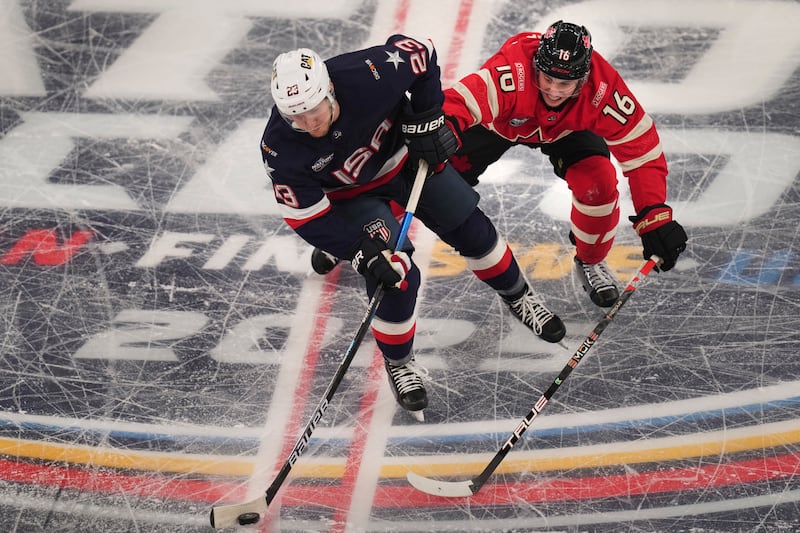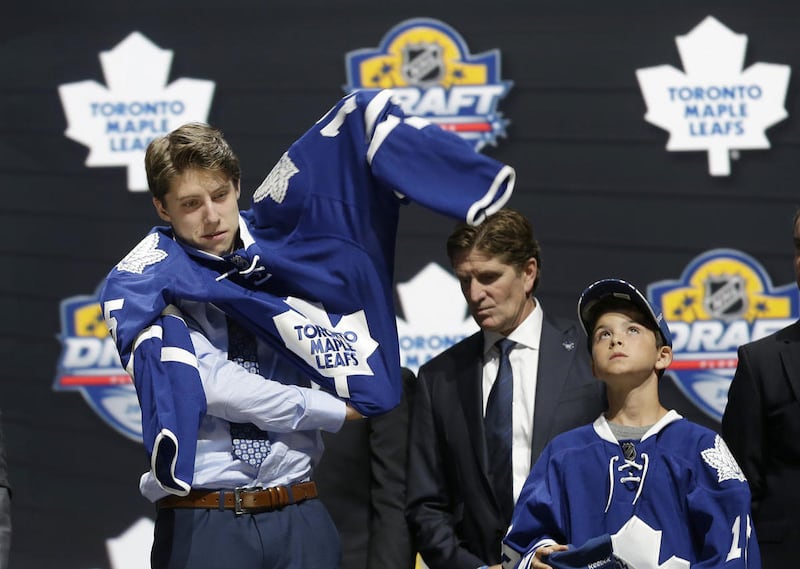Mitch Marner draws smiley faces on his gloves to remind himself that hockey is supposed to be fun.
He spent his entire childhood battling his father’s expectations, which some might label as extreme. When he was drafted by his childhood favorite team, the Toronto Maple Leafs, and soon handed the biggest contract ever given to a 22-year-old, those expectations remained — but rather than receiving pressure from just one person, it came from the millions who cheer for hockey’s most popular team.
Many believe that escaping the Toronto microscope in favor of a quieter market would allow him to thrive. That leads some to draw a straight line between him and Utah.
To put it into perspective, most of Utah’s practices last year were attended by four beat writers and one TV camera crew, in addition to team staff and a reporter or two covering the opposing team. But when the Maple Leafs were in town, there were so many reporters you could hardly get your microphone close enough to pick up the audio — hence the telescopic poles that most of the visiting media had attached to their microphones.
That amount of coverage, combined with so many vocal fans on social media, can take a toll on players, especially those that have been there as long and get paid as much as Marner.
But Marner dismissed that notion in his exit interview.
“There’s pressure anywhere,” he said. “Doesn’t matter where you are, there’s always pressure and we put the most pressure on ourselves. ... We hold ourselves to such high accountability that the pressures from the outside, I don’t think, really bother you too much.”
He did, though, speak of his time in Toronto in a reminiscent tone.
“I’ve always loved my time here,” he said. “I’ve loved being here. ... I’ve been so grateful and I haven’t processed anything yet.”
What to know about Mitch Marner
Marner is an elite playmaker.
He crossed the 100-point threshold this year, finishing with 102 in 81 games. He’s played at a 100-point pace for five consecutive seasons, though the two pandemic-shortened seasons and some minor injuries had prevented him from actually reaching it.
Even still, he’s the fifth-leading scorer in the Maple Leafs’ 108-year history.
Utah could use another point-getter. It lost by one goal 20 times this year. Changing the outcome in even a handful of them would have brought playoff hockey to the Delta Center.
Marner’s also renowned for his defensive play. He plays on Toronto’s first penalty kill unit (the fourth-best in the league these playoffs) and he’s always on the ice in key situations — must-score and must-defend. In all but one of his NHL seasons, he’s received Selke Trophy votes as the best two-way forward in the league.
Utah’s top PK unit of Kevin Stenlund and Marner’s former teammate, Alexander Kerfoot, was largely successful this year — to the point where they might not want to adjust it. But adding Marner would give them both depth and flexibility in that area, and if they were to choose not to use him on the penalty kill, he’d have more energy for offensive zone situations.
The main criticism Marner receives is that his production decreases in the playoffs. But even then, he’s still well above league average in all major statistical categories. With less external pressure in a different market, he might be able to achieve the postseason success he’s expected to have.
Would Mitch Marner fit in Utah?
Utah often found itself one top-six winger short this year. Nearly everyone on the team got a shot in that spot, but nobody seemed to stick. Marner would.
During most of his time in Toronto, Marner was stapled to Auston Matthews’ wing. Marner’s playmaking combined with Matthews’ shot produced plenty of nightmares for opposing goalies.
Utah has an elite shooter of its own: Dylan Guenther. Both Guenther and Marner play right wing, so it might not work to permanently have them on the same line, but Marner typically plays the point on the power play — and that could turn the Mammoth into a serious threat.
An argument against signing Marner is his size. It’s not that he’s tiny or anything, but he isn’t the physical presence that many argue Utah needs. Big top-six forwards are hard to come by, but Utah does have a few coming up through the pipeline. They won’t need him to play a physical game — they’ll need him to put the puck in the net.
A signing like that could accelerate the rebuild and put open Utah’s window of contention earlier than anyone had anticipated.
Does Utah have the cap space to sign Mitch Marner?
PuckPedia projects the Mammoth to have $21,157,143 in cap space next year. General manager Bill Armstrong has publicly stated that he has no internal budget restrictions from ownership in terms of player payroll, so if he wants to spend it all, he can.
A keen observer will note that that’s only the 16th-most cap space in the league, but the same observer should also realize that most of the teams above Utah have plenty of roster spots to fill. Utah’s business is already almost done, so that cap space is open.
Mikko Rantanen just signed for $12 million and Leon Draisaitl signed for $14 million, so anywhere in that range is probably Marner’s market value. At that rate, coming to Utah as opposed to staying in Ontario would save him more than $1.5 million in taxes.


